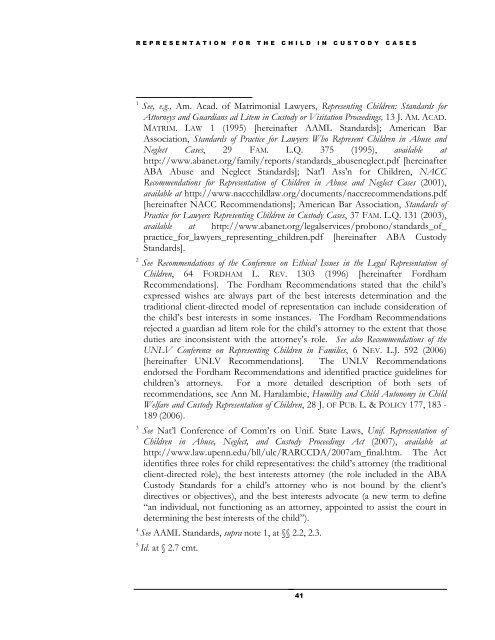A Judge’s Guide
A Judge’s Guide
A Judge’s Guide
Create successful ePaper yourself
Turn your PDF publications into a flip-book with our unique Google optimized e-Paper software.
REPRESENTATION FOR THE CHILD IN CUSTODY CASES<br />
1<br />
See, e.g., Am. Acad. of Matrimonial Lawyers, Representing Children: Standards for<br />
Attorneys and Guardians ad Litem in Custody or Visitation Proceedings, 13 J. AM.ACAD.<br />
MATRIM. LAW 1 (1995) [hereinafter AAML Standards]; American Bar<br />
Association, Standards of Practice for Lawyers Who Represent Children in Abuse and<br />
Neglect Cases, 29 FAM. L.Q. 375 (1995), available at<br />
http://www.abanet.org/family/reports/standards_abuseneglect.pdf [hereinafter<br />
ABA Abuse and Neglect Standards]; Nat'l Ass'n for Children, NACC<br />
Recommendations for Representation of Children in Abuse and Neglect Cases (2001),<br />
available at http://www.naccchildlaw.org/documents/naccrecommendations.pdf<br />
[hereinafter NACC Recommendations]; American Bar Association, Standards of<br />
Practice for Lawyers Representing Children in Custody Cases, 37 FAM. L.Q. 131 (2003),<br />
available at http://www.abanet.org/legalservices/probono/standards_of_<br />
practice_for_lawyers_representing_children.pdf [hereinafter ABA Custody<br />
Standards].<br />
2<br />
See Recommendations of the Conference on Ethical Issues in the Legal Representation of<br />
Children, 64 FORDHAM L. REV. 1303 (1996) [hereinafter Fordham<br />
Recommendations]. The Fordham Recommendations stated that the child’s<br />
expressed wishes are always part of the best interests determination and the<br />
traditional client-directed model of representation can include consideration of<br />
the child’s best interests in some instances. The Fordham Recommendations<br />
rejected a guardian ad litem role for the child’s attorney to the extent that those<br />
duties are inconsistent with the attorney’s role. See also Recommendations of the<br />
UNLV Conference on Representing Children in Families, 6 NEV. L.J. 592 (2006)<br />
[hereinafter UNLV Recommendations]. The UNLV Recommendations<br />
endorsed the Fordham Recommendations and identified practice guidelines for<br />
children’s attorneys. For a more detailed description of both sets of<br />
recommendations, see Ann M. Haralambie, Humility and Child Autonomy in Child<br />
Welfare and Custody Representation of Children, 28 J. OF PUB.L.&POLICY 177, 183 -<br />
189 (2006).<br />
3<br />
See Nat’l Conference of Comm’rs on Unif. State Laws, Unif. Representation of<br />
Children in Abuse, Neglect, and Custody Proceedings Act (2007), available at<br />
http://www.law.upenn.edu/bll/ulc/RARCCDA/2007am_final.htm. The Act<br />
identifies three roles for child representatives: the child’s attorney (the traditional<br />
client-directed role), the best interests attorney (the role included in the ABA<br />
Custody Standards for a child’s attorney who is not bound by the client’s<br />
directives or objectives), and the best interests advocate (a new term to define<br />
“an individual, not functioning as an attorney, appointed to assist the court in<br />
determining the best interests of the child”).<br />
4<br />
See AAML Standards, supra note 1, at §§ 2.2, 2.3.<br />
5 Id. at § 2.7 cmt.<br />
41


